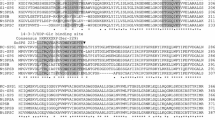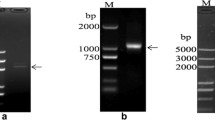Summary
Using probes obtained by PCR amplification, we have isolated two cognate rice cDNAs (cdc2Os-1 andcdc2Os-2) encoding structural homologues of thecdc2 +/CDC28(cdc2) protein kinase from a cDNA library prepared from cultured rice cells. Comparison of the deduced amino acid sequences of cdc2Os-1 and cdc2Os-2 showed that they are 83 % identical. They are 62 % identical toCDC28 ofSaccharomyces cerevisiae and much more similar to the yeast and mammalian p34cdc2 kinases than to riceR2, acdc2-related kinase isolated previously by screening the same rice cDNA library with a different oligonucleotide probe. Southern blot analysis indicated that the three rice clones (cdc2Os-1,cdc2Os-2 andR2) are derived from distinct genes and are each found in a single copy per rice haploid genome. RNA blot analysis revealed that these genes are expressed in proliferating rice cells and in young rice seedlings.cdc2Os-1 could complement a temperature-sensitive yeast mutant ofcdc28. However, despite the similarity in structure, bothcdc2Os-2 andR2 were unable to complement the same mutant. Thus, the present results demonstrate the presence of structurally related, but functionally distinct cognates of thecdc2 cell cycle kinase in rice.
Similar content being viewed by others
References
Bourouis M, Moore P, Ruel L, Gran Y, Heitzler P, Simpson P (1990) An early embryonic product of the geneshaggy encodes a serine/threonine protein kinase related to the CDC28/cdc2+ subfamily. EMBO J 9:2877–2884
Carr AM, MacNeill SA, Nurse P (1989) Molecular cloning and sequence analysis of mutant alleles of the fission yeastcdc2 protein kinase gene: Implications forcdc2 + protein structure and function. Mol Gen Genet 218:41–49
Colasanti J, Tyers M, Sundaresan V (1991) Isolation and characterization of cDNA clones encoding a functional p34cdc2 homologue fromZea mays. Proc Natl Acad Sci USA 88:3377–3381
Courchesne WE, Kunisawa R, Thorner J (1989) A putative protein kinase overcomes pheromone-induced arrest of cell cycling inS. cerevisiae. Cell 58:1107–1119
Elledge SJ, Spottswood R (1991) A new human p34 protein kinase, CDK2, identified by complementation of acdc28 mutation inSaccharomyces cerevisiae, is a homolog ofXenopus Egl. EMBO J 9:2653–2659
Elion EA, Grisafi PL, Fink R (1990)FUS3 encodes a cdc2+/CDC28-related kinase required for the transition from mitosis into conjugation. Cell 60:649–664
Feiler HS, Jacobs TW (1990) Cell division in higher plants: Acdc2 gene, its 34-kDa product, and histone H1 kinase activity in pea. Proc Natl Acad Sci USA 87:5397–5401
Feinberg AP, Vogelstein B (1983) A technique for radiolabelling DNA restriction endonuclease fragments to high specific activity. Anal Biochem 132:6–13
Ferreira PCG, Hemerly AS, Villarroel R, Van Montagu M, Inze D (1991) TheArabidopsis functional homolog of the p34cdc2 protein kinase. Plant Cell 3:531–540
Hanks SK, Quinn AM, Hunter T (1988) The protein kinase family: Conserved features and deduced phylogeny of the catalytic domains. Science 241:42–52
Hata S (1991) cDNA cloning of a novel cdc2+/CDC28-related protein kinase from rice. FEBS Lett 279:149–152
Hata S, Kouchi H, Suzuka I, Ishii T (1991) Isolation and characterization of cDNA clones for plant cyclins. EMBO J, 10:2653–2659
Hindley J, Phear GA (1984) Sequence of the cell division geneCDC2 fromSchizosaccharomyces pombe; patterns of splicing and homology to protein kinases. Gene 31:129–134
Hirt H, Pay A, Gyorgyey J, BaKo L, Nemeth K, Bogre L, Schweyen RJ, Heberle-Bors E, Dudits D (1991) Complementation of a yeast cell cycle mutant by an alfalfa cDNA encoding a protein kinase homologous to p34cdc2. Proc Natl Acad Sci USA 88:1636–1640
Irie K, Nomoto S, Miyajima I, Matsumoto K (1991)SGV1 encodes aCDC28/cdc2-related kinase required for a G subunit-mediated adaptive response to pheromone inS. cerevisiae. Cell 65:785–795
Ito H, Fukuda Y, Murata K, Kimura A (1983) Transformation of intact yeast cells treated with alkali cations. J Bacteriol 153:163–168
Jimenez J, Alphey L, Nurse P, Glover DM (1990) Complementation of fission yeastcdc2 ts andcdc25 ts mutants identifies two cell cycle genes fromDrosophila: acdc2 homologues andstring. EMBO J 9:3565–3571
John PCL, Sek FJ, Lee MG (1989) A homolog of the cell cycle control protein p34cdc2 participates in the division cycle ofChlamydomonas, and a similar protein is detectable in higher plants and remote taxa. Plant Cell 1:1185–1193
Krek W, Nigg EA (1989) Structure and developmental expression of the chickenCDC2 kinase. EMBO J 8:3071–3078
Krek W, Nigg EA (1991) Differential phosphorylation of vertebrate p34cdc2 kinase at the G1/S and G2/M transitions of the cell cycle: identification of major phosphorylation sites. EMBO J 10:305–316
Lee MG, Nurse P (1987) Complementation used to clone a human homologue of the fission yeast cell cycle control genecdc2. Nature 327:31–35
Lehner CF, O'Farrell PH (1990)Drosophila cdc2 homologs: a functional homolog is expressed with a cognate variant. EMBO J 9:3573–3581
Lörinz AT, Reed SI (1984) Primary structure homology between the product of yeast cell division control geneCDC28 and vertebrate oncogenes. Nature 307:183–185
Lörinz AT, Reed SI (1986) Sequence analysis of temperaturesensitive mutations in theSaccharomyces cerevisiae geneCDC28. Mol Cell Biol 6:4099–4103
Lewin B (1990) Driving the cell cycle: M phase kinase, its partners, and substrates. Cell 61:743–752
Matsushime H, Roussel MF, Ashmun R, Sherr CJ (1991) Colony-stimulating factor 1 regulates novel cyclins during the G1 phase of the cell cycle. Cell 65:701–713
Minshull J, Golsteyn R, Hill CS, Hunt T (1990) The A- and B-type cyclin associated cdc2 kinases inXenopus turn on and off at different times in the cell cycle. EMBO J 9:2865–2875
Ninomiya-Tsuji J, Nomoto S, Yasuda H, Reed SI, Matsumoto K (1991) Cloning of a human cDNA encoding a CDC2-related kinase by complementation of a budding yeastcdc28 mutation. Proc Natl Acad Sci USA 88:9006–9010
Nurse P (1990) Universal control mechanism regulating onset of M-phase. Nature 344:503–508
Nurse P, Bissett Y (1981) Gene required in G1 for commitment to cell cycle and in G2 for control of mitosis in fission yeast. Nature 292:558–560
Paris J, Guellec RL, Couturier A, Guellec KL, Omilli F, Camonis J, MacNeill S, Philippe M (1991) Cloning by differential screening of aXenopus cDNA coding for a protein highly homologous tocdc2. Proc Natl Acad Sci USA 88:1039–1043
Pines J, Hunter T (1990a) p34cdc2: the S and M kinase? New Biologist 2:389–401
Pines J, Hunter T (1990b) Human cyclin A is adenovirus E1A-associated protein p60 and behaves differently from cyclin B. Nature 346:760–763
Reed SI (1980) The selection ofS. cerevisiae mutants defective in the start event of cell division. Genetics 95:561–577
Reed SI, Wittenberg C (1990) Mitotic role for the CDC28 protein kinase ofSaccharomyces cerevisiae. Proc Natl Acad Sci USA 87:5697–5701
Sambrook J, Fritsch EF, Maniatis T (1989) Molecular cloning. Cold Spring Harbor Laboratory Press. Cold Spring Harbor
Sherman F, Fink GR, Hicks JB (1986) Methods in yeast genetics. Cold Spring Harbor Laboratory Press. Cold Spring Harbor, New York
Shuttleworth J, Godfrey R, Colman A (1990) p40MO15 acdc2-related kinase involved in negative regulation of meiotic maturation ofXenopus oocytes. EMBO J 9:3233–3240
Simon M, Seraphin B, Faye G (1986)KIN28, a yeast split gene coding for a putative protein kinase homologous toCDC28. EMBO J 5:2697–2701
Solomon MJ, Glotzer M, Lee TH, Phillipe M, Kirschner MW (1990) Cyclin activation of p34cdc2. Cell 63:1013–1024
Tajima M, Nogi Y, Fukasawa T (1986) Duplicate upstream activating sequences in the promoter region of theSaccharomyces cerevisiae GAL7 gene. Mol Cell Biol 6:249–256
Takaiwa F, Oono K, Sugiura M (1984) The complete nucleotide sequence of a rice 17S rRNA gene. Nucleic Acids Res 12:5441–5448
Tsai LH, Harlow E, Meyerson M (1991) Isolation of thecdc2 gene that encodes the cyclin A- and adenovirus E1A-associated p33 kinase. Nature 353:174–177
Uesono Y, Tanaka K, Toh-e A (1987) Negative regulators of the PHO system inSaccharomyces cerevisiae: isolation and structural characterization ofPHO85. Nucl Acids Res 15:10299–10309
Author information
Authors and Affiliations
Additional information
Communicated by K. Isono
The nucleotide sequence data in this paper have been deposited in the EMBL database under accession number X60374 (cdc2Os-1) and X60375 (cdc2Os-2)
Rights and permissions
About this article
Cite this article
Hashimoto, J., Hirabayashi, T., Hayano, Y. et al. Isolation and characterization of cDNA clones encodingcdc2 homologues fromOryza sativa: a functional homologue and cognate variants. Molec. Gen. Genet. 233, 10–16 (1992). https://doi.org/10.1007/BF00587555
Received:
Issue Date:
DOI: https://doi.org/10.1007/BF00587555




